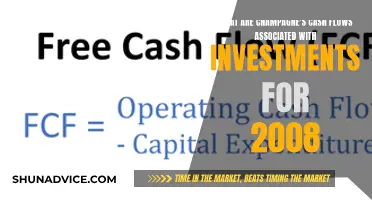
Angel investors are individuals who provide seed money to startup businesses, usually in exchange for an equity stake in the company. They are often wealthy individuals who are looking for a higher rate of return than more traditional investments can offer. Angel investments are typically made during the early stages of a company's life cycle, and they can be very lucrative. However, they are also risky, as the majority of new businesses fail. To track and value angel investments appropriately, investors need to understand key principles such as the difference between book value and equity value, reasonable valuations and dilution, cash flow and returns, and the potential for tax benefits. One way to simplify managing angel investments is by using a platform to track performance and important documents. A company's cash flow statement is one of its financial reports, and it is important because it shows how a company is allocating cash and can indicate its financial health. The cash flow statement has three sections: cash flow from operating activities, cash flow from investing activities, and cash flow from financing activities. This article will discuss where to put angel investments in a cash flow statement.
What You'll Learn

Operating Activities
The cash flow statement is one of the three main financial statements required in standard financial reporting. It is used to determine the financial success of a company's core business activities and is an important benchmark for investors.
The operating activities section of the cash flow statement can be displayed using the direct or indirect method. The direct method records all transactions on a cash basis and displays the actual cash inflows and outflows during the accounting period. The indirect method begins with net income from the income statement and then adds back non-cash items to arrive at a cash basis figure. Most companies use the accrual basis accounting method, so the income statement and balance sheet figures will be consistent with the indirect method.
The cash flow from operating activities includes:
- Salaries paid out to employees
- Cash paid to vendors and suppliers
- Cash collected from customers
- Interest income and dividends received
- Income tax paid and interest paid
- Net income from the income statement
- Adjustments to net income, including non-cash expenses such as depreciation and amortization
- Changes in working capital, including adjustments for changes in accounts receivable, inventory, accounts payable, and other operating assets and liabilities
The cash flow from operating activities is an important measure of a company's financial health and liquidity. It allows business owners and operators to understand where the money is coming from and going to, and it helps them make efficient financing decisions and maintain sufficient cash for operational efficiency.
Cash App Investing: Smart Move or Risky Gamble?
You may want to see also

Financing Activities
The formula for calculating the cash flow from financing activities is:
> Cash Flow from Financing = Debt Issuances + Equity Issuances + (Share Buybacks) + (Debt Repayment) + (Dividends)
In this formula, debt and equity issuances are shown as positive cash inflows since the business is raising capital (i.e. cash proceeds). On the other hand, share buybacks, debt repayments, and dividends are represented as cash outflows.
Angel investors are individuals who provide seed money to startup businesses, usually in exchange for an equity stake in the company. They are often wealthy individuals looking for a higher rate of return than more traditional investments can offer. Angel investors are not providing loans, but rather investing in an idea they like, with the expectation of a reward only if and when the business succeeds.
Owner's Investment Cash: Operating Activity?
You may want to see also

Investing Activities
The "Investing Activities" section of a company's cash flow statement outlines the cash inflows and outflows from investment-related activities over a specific period. This includes purchases of physical assets, investments in securities, and the sale of securities or assets.
- Purchase of physical assets, such as property, plant, and equipment (PP&E)
- Sale of PP&E
- Acquisitions of other businesses or companies
- Sale of other businesses (divestitures)
- Purchase of marketable securities (e.g. stocks, bonds)
- Sale of marketable securities
- Loans made to third parties
- Collection of loans
It is important to note that investing activities do not include short-term investments or cash equivalents, which are classified under operating activities, nor do they include cash flows from financing activities.
The total cash flow from investing activities in an accounting period is calculated by adding together both the positive and negative investing activities listed on the cash flow statement. A negative cash flow from investing activities is not necessarily a bad sign, as it could indicate that management is investing in the long-term health of the company.
For example, a company may invest in fixed assets such as property, plant, and equipment to grow the business. While this may result in a negative cash flow from investing activities in the short term, it could help generate cash flow in the long term.
To calculate the cash flow from investing activities, you can use the following formula:
Cash flow from investing activities = CapEx/purchase of non-current assets + marketable securities + business acquisitions – divestitures (sale of investments)
This formula allows you to determine the net cash flow from investing activities, providing insights into a company's capital expenditure and investment strategies.
Settled Cash for Investment: What's Available and How?
You may want to see also

Cash Flow Statement Purpose
A cash flow statement is a financial statement that provides insights into a company's financial health and operational efficiency. It is one of the three main financial statements, complementing the balance sheet and the income statement. The statement summarises the amount of cash and cash equivalents entering and leaving a company, highlighting its cash management capabilities.
The purpose of a cash flow statement is to provide a detailed picture of the cash flow of a business over a specified period, known as the accounting period. It demonstrates a company's ability to operate in the short and long term, based on how much cash is flowing into and out of the business. The statement is divided into three sections:
- Operating activities: This section details the cash flow generated from the company's regular goods or services, including both revenue and expenses. It reflects how much cash is generated from the company's core operations.
- Investing activities: This section includes cash flow from purchasing or selling assets, such as physical property (real estate, vehicles) and non-physical property (patents). It reflects the changes in the company's capital expenditures and investments in future operations.
- Financing activities: This section details the cash flow from debt and equity financing, including transactions such as issuing stocks or bonds, borrowing from banks, and repaying debt. It provides an overview of the company's external financing activities.
By analysing the cash flow statement, investors can make better-informed decisions about their investments, assessing the company's financial health and stability. It also helps investors understand the company's ability to pay off its debts and fund its operating expenses. Additionally, the statement is useful for business owners and entrepreneurs, as it provides insights into business performance, helping them adjust strategies and make informed decisions about growth and expansion.
Corporations' Cash Investment Strategies: Unlocking Business Growth
You may want to see also

Calculating Cash Flow
A cash flow statement is a financial statement that tracks the inflow and outflow of cash, providing insights into a company's financial health and operational efficiency. It is one of the three main financial statements, complementing the balance sheet and the income statement. The cash flow statement is an important tool for creditors and investors to assess a company's liquidity and financial health.
The two primary methods for calculating cash flow are the direct method and the indirect method.
Direct Method
The direct method for calculating cash flow involves listing all cash receipts and payments during the reporting period. This method is commonly used by small businesses that use the cash basis accounting method. The figures can be calculated by examining the net decrease or increase in asset and liability accounts. The direct method presents cash flow information in a straightforward manner.
Indirect Method
The indirect method for calculating cash flow starts with net income and adjusts for changes in non-cash transactions. This method is often used by companies that employ the accrual basis accounting method, where revenue is recognised when it is earned rather than received. As a result, certain non-cash items, such as depreciation and amortisation, need to be reevaluated when calculating cash flow from operations.
Cash Flow from Operating Activities
Cash flow from operating activities reflects the sources and uses of cash from a company's business activities. It includes cash receipts from sales of goods and services, as well as cash payments to suppliers, employees, interest, and income taxes. To calculate net cash flow from operating activities, subtract total cash payments from total cash receipts.
Cash Flow from Investing Activities
Cash flow from investing activities includes any sources and uses of cash from a company's investments. This category encompasses purchases or sales of assets, loans made or received, and payments related to mergers and acquisitions. Changes in equipment, assets, or investments relate to cash flow from investing activities. To calculate net cash flow from investing activities, subtract cash payments for investments from cash receipts from sales of investments.
Cash Flow from Financing Activities
Cash flow from financing activities includes sources of cash from investors and banks, as well as cash paid to shareholders in the form of dividends, stock repurchases, and debt repayments. Changes in cash from financing activities are considered cash-in when capital is raised and cash-out when dividends are paid. To calculate net cash flow from financing activities, subtract cash payments for financing activities from cash receipts from financing activities.
Combining Sections and Reconciliation
To determine the overall change in cash and cash equivalents for the period, add the net cash flows from operating, investing, and financing activities. Finally, reconcile this amount with the beginning cash balance to arrive at the ending cash balance, ensuring it matches the cash balance reported on the balance sheet.
Angel Investments and Cash Flow
Angel investments are typically made by wealthy individuals who provide capital to startup companies during their early stages in exchange for an equity stake. Angel investors should monitor the cash flow from their investments to determine their total return on investment. One way to do this is by multiplying the company's revenue by the percentage of revenue the investor is entitled to. Additionally, angel investors may qualify for tax benefits, such as depreciation and expensing of startup costs, which can help reduce their tax liability.
Emergency Cash: Best Places to Invest for Quick Access
You may want to see also
Frequently asked questions
An angel investor is an individual who provides capital to a business, usually during its early stages, in exchange for convertible debt or ownership equity. Angel investors often provide support to startups when most other investors are not prepared to back them.
A cash flow statement (CFS) tracks the inflow and outflow of cash, providing insights into a company's financial health and operational efficiency. It is one of the three main financial statements, alongside the balance sheet and the income statement.
Angel investment shows up on a cash flow statement under "Cash Flow from Financing Activities". This includes the sources of cash from investors and banks, as well as the way cash is paid to shareholders.
The other two sections of a cash flow statement are "Cash Flow from Operating Activities" and "Cash Flow from Investing Activities".
Operating activities include any sources and uses of cash from business activities. This includes receipts from sales of goods and services, payments made to suppliers, salary and wage payments to employees, and any other type of operating expenses.







